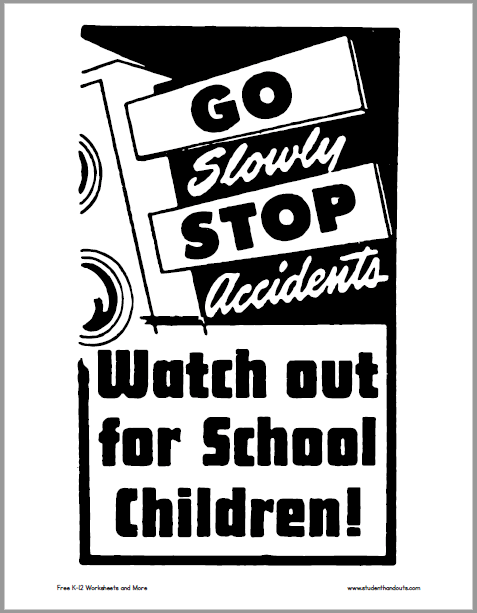| "Go Slowly—Stop Accidents" Printable Classroom Sign |
|---|
| www.studenthandouts.com ↣ Classroom Organization ↣ Classroom Signs |
 |
    |
|
"Go slowly. Stop accidents. Watch out for school children." Click here to print.
It is important that children do not run in the classroom or school hallways for several reasons, including safety, discipline, and maintaining a conducive learning environment. Safety: Running in confined indoor spaces like classrooms and hallways can pose a significant safety risk. Children might collide with each other, trip, or bump into objects, leading to accidents, injuries, and potential liability for the school. Risk of Falls: Running increases the likelihood of slips and falls, which can result in injuries like sprained ankles, broken bones, or head bumps. These accidents can disrupt a child's education and incur medical expenses. Distraction: Running in the classroom or hallways can be disruptive to other students and teachers. It creates noise and chaos, making it difficult for everyone to focus on learning and instruction. Damage to Property: Running may lead to damage to school property, such as knocking over desks or chairs, damaging lockers, or scuffing walls. Repairing or replacing damaged property can be costly for the school. Lack of Discipline: Encouraging students to walk calmly in indoor spaces reinforces discipline and respect for rules. Teaching them to control their movement fosters self-discipline and helps create an orderly classroom environment. Respect for Others: Running in shared spaces can be seen as inconsiderate behavior. It may inconvenience and disturb other students and staff members who are trying to work, study, or move about the school in an organized manner. Emergency Preparedness: In the event of an emergency, such as a fire drill or lockdown, students need to move in an orderly and controlled fashion to ensure their safety. Running can lead to chaos and confusion during such situations. Professionalism: Schools aim to instill in students a sense of professionalism and appropriate behavior. Running in indoor spaces is generally considered unprofessional and does not align with the expectations of a school environment. Positive Learning Environment: A calm and orderly environment is conducive to learning. Running disrupts this environment and can hinder students' ability to concentrate on their studies. Promotion of Physical Activity: While running indoors is discouraged for safety reasons, schools often provide opportunities for physical activity through structured recess and physical education classes, where students can run and engage in active play in designated areas. To promote a safe and respectful learning environment, it is essential for schools and teachers to establish clear rules and expectations regarding movement within the classroom and school hallways. By teaching and reinforcing these expectations, schools can help ensure the well-being of students, staff, and the overall school community. |
| www.studenthandouts.com ↣ Classroom Organization ↣ Classroom Signs |








